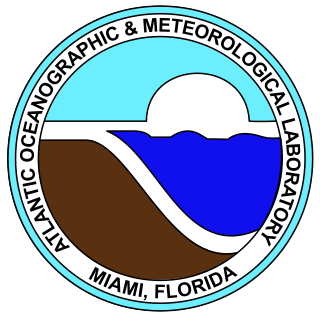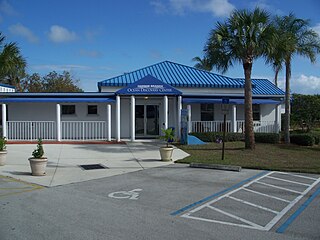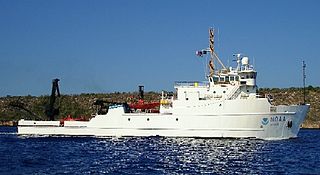
The National Oceanic and Atmospheric Administration is an American scientific agency within the United States Department of Commerce that focuses on the conditions of the oceans, major waterways, and the atmosphere.
The National Ocean Service (NOS), an office within the U.S. Department of Commerce National Oceanic and Atmospheric Administration (NOAA), is responsible for preserving and enhancing the nation’s coastal resources and ecosystems along 95,000 miles (153,000 km) of shoreline bordering 3,500,000 square miles (9,100,000 km2) of coastal, Great Lakes, and ocean waters. Its mission is to "provide science-based solutions through collaborative partnerships to address evolving economic, environmental, and social pressures on our oceans and coasts." NOS works closely with many partner agencies to ensure that ocean and coastal areas are safe, healthy, and productive. National Ocean Service scientists, natural resource managers, and specialists ensure safe and efficient marine transportation, promote innovative solutions to protect coastal communities, and conserve marine and coastal places. NOS is a scientific and technical organization of 1,700 scientists, natural resource managers, and specialists in many different fields. NOS delivers a dynamic range of nationwide coastal and Great Lakes scientific, technical, and resource management services in support of safe, healthy, and productive oceans and coasts. NOS develops partnerships to integrate expertise and efforts across all levels of government and with other interests to protect, maintain, and sustain the viability of coastal communities, economies and ecosystems.
The National Oceanographic Data Center (NODC) was one of the national environmental data centers operated by the National Oceanic and Atmospheric Administration (NOAA) of the U.S. Department of Commerce. The main NODC facility was located in Silver Spring, Maryland and was made up of five divisions. The NODC also had field offices collocated with major government or academic oceanographic laboratories in Stennis Space Center, MS; Miami, FL; La Jolla, San Diego, California; Seattle, WA; Austin, Texas; Charleston, South Carolina; Norfolk, Virginia; and Honolulu, Hawaii. In 2015, NODC was merged with the National Climatic Data Center and the National Geophysical Data Center into the National Centers for Environmental Information (NCEI).

The National Marine Fisheries Service (NMFS) is the United States federal agency responsible for the stewardship of national marine resources. The agency conserves and manages fisheries to promote sustainability and prevent lost economic potential associated with overfishing, declining species, and degraded habitats.

The Atlantic Oceanographic and Meteorological Laboratory (AOML), a federal research laboratory, is part of National Oceanic and Atmospheric Administration's (NOAA) Office of Oceanic and Atmospheric Research (OAR), located in Miami, Florida. AOML's research spans tropical cyclone and hurricanes, coastal ecosystems, oceans and human health, climate studies, global carbon systems, and ocean observations. It is one of seven NOAA Research Laboratories (RLs).
The Pacific Marine Environmental Laboratory (PMEL) is a laboratory in the National Oceanic and Atmospheric Administration (NOAA) Office of Oceanic and Atmospheric Research (OAR). It is one of seven NOAA Research Laboratories (RLs). The PMEL is split across two sites in the Pacific Northwest, in Seattle, Washington and Newport, Oregon.
The Cooperative Institute for Marine and Atmospheric Studies (CIMAS) is a research institute of the University of Miami located in the Rosenstiel School of Marine and Atmospheric Science (RSMAS). CIMAS serves as a mechanism to bring together the research resources of the Partner Universities with those of the National Oceanic and Atmospheric Administration (NOAA) in order to develop a Center of Excellence that is relevant to understanding the Earth’s oceans and atmosphere within the context of NOAA’s mission. In 2010 CIMAS was restructured in light of its successful submission to a competitive award program to keep pace with changes in scientific and societal priorities as well as changes in both the NOAA and university regional context. It is one of 16 NOAA Cooperative Institutes (CIs).

The United States Fish Commission, formally known as the United States Commission of Fish and Fisheries, was an agency of the United States government created in 1871 to investigate, promote, and preserve the fisheries of the United States. In 1903, it was reorganized as the United States Bureau of Fisheries, which operated until 1940. In 1940, the Commission became part of the newly created United States Fish and Wildlife Service, under the United States Department of the Interior.

Harbor Branch Oceanographic Institute at Florida Atlantic University, also commonly referred to as HBOI or HBOI at FAU, is a non-profit oceanographic institution operated by Florida Atlantic University in Fort Pierce, Florida, United States. HBOI traces its history to a 1971 entity which partnered with FAU in 2007.

The Environmental Science Services Administration (ESSA) was a United States Federal executive agency created in 1965 as part of a reorganization of the United States Department of Commerce. Its mission was to unify and oversee the meteorological, climatological, hydrographic, and geodesic operations of the United States. It operated until 1970, when it was replaced by the new National Oceanic and Atmospheric Administration (NOAA).
The National Undersea Research Center for the North Atlantic and Great Lakes (NURC-NA&GL) is one of six undersea centers established by the National Oceanic and Atmospheric Administration's Undersea Research Program. It is co-located with the University of Connecticut’s Department of Marine Sciences. The center's mission includes supporting regional and national oceanography research and promoting awareness of the oceanic ecosystem through educational outreach programs.

The NOAA Ship Nancy Foster is a National Oceanic and Atmospheric Administration research vessel.

Hatfield Marine Science Center (HMSC) is a marine science research and education center next to Yaquina Bay of the Pacific Ocean in the U.S. state of Oregon. It is operated by Oregon State University (OSU) in cooperation with five state and federal agencies co-located on site. Named after Mark Hatfield, a former U.S. Senator from Oregon, the HMSC occupies a 49-acre (20 ha) site in Newport. The Hatfield Marine Science Center campus is the future site of the new Oregon State University Marine Studies Initiative building, with a proposed year-round undergraduate student body of 500 students.
The National Institute for Undersea Science and Technology (NIUST) was established in 2002 within NOAA for the purpose of advancing undersea research. NOAA's undersea research program is carried out through six regional research centers and a national institute based at academic institutions with established programs in marine science and technology.

Pisces class submersibles are three person research deep-submergence vehicles designed and built by Hyco International Hydrodynamics of North Vancouver in British Columbia with a maximum operating depth of 2,000 m (6,560 ft). The vehicles have multiple view ports, sample collecting, environmental sensing, and instrument placement capabilities. The pressure hull has a 7 ft (2.1 m) inside diameter and is made of HY-100 steel with 3 forward-looking acrylic windows, 6 in (15 cm) in diameter. Designed by Alan Trice, the Pisces series of submersibles are representative of early manned submersibles built in the late 1960s and were proven workhorses in offshore exploration and oceanographic research. Pisces II was the first production model of the design and was completed in 1968, with 9 more Pisces subs built before the manufacturer folded in the late 1970s.

Rear Admiral Harley D. Nygren is a retired officer who served in the United States Coast and Geodetic Survey Corps, its successor, the Environmental Science Services Administration Corps, and the ESSA Corps's successor, the National Oceanic and Atmospheric Administration Commissioned Officer Corps. He served as the first Director of the NOAA Corps.

Rear Admiral Sigmund R. Petersen is a retired career officer who served in the United States Coast and Geodetic Survey Corps, its successor, the Environmental Science Services Administration Corps, and the ESSA Corps's successor, the National Oceanic and Atmospheric Administration Commissioned Officer Corps. He served as the fourth Director of the NOAA Corps.

NOAAS Oregon , previously NOAAS Oregon , was an American fisheries research vessel in commission in the National Oceanic and Atmospheric Administration (NOAA) fleet from 1970 to 1980. Prior to her NOAA career, she operated under the United States Fish and Wildlife Service from 1949 to 1970 as R/V Oregon .












